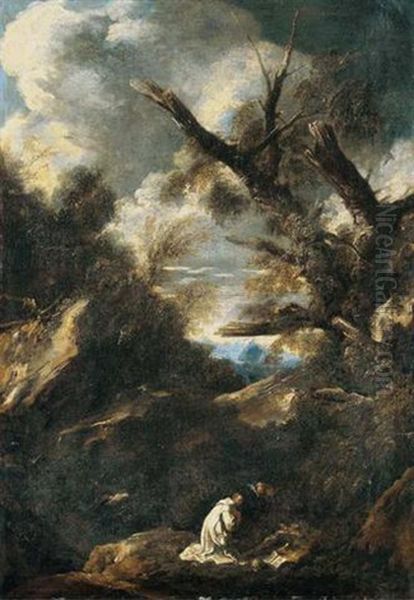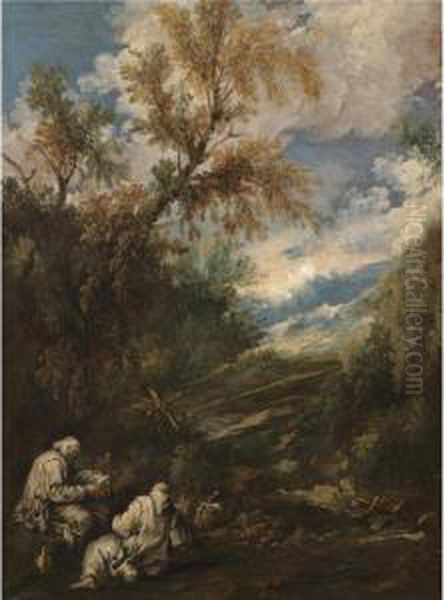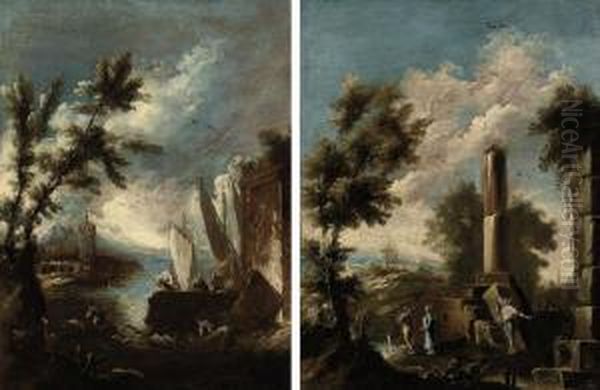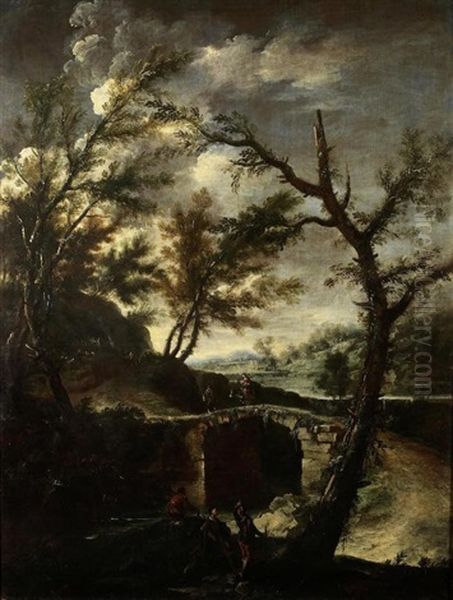Introduction: Ancona's Gift to Landscape Painting
Antonio Francesco Peruzzini stands as a significant figure in the transition of Italian landscape painting from the structured ideals of the High Baroque towards a more dynamic, atmospheric, and emotionally charged vision that foreshadowed the Rococo and even Romantic sensibilities. Born in Ancona, a city nestled in the Marche region of Italy, Peruzzini carved a distinct niche for himself, primarily as a landscape specialist. His life and career spanned a period of rich artistic ferment, and his long-standing collaboration with the Genoese figure painter Alessandro Magnasco produced some of the most unique and evocative works of the late 17th and early 18th centuries. Though sometimes overshadowed by his collaborator or by artists working in the more dominant classical tradition, Peruzzini's contribution was substantial, marked by vigorous brushwork, dramatic compositions, and a profound feeling for the wilder aspects of nature.
Early Life and Formative Influences
Pinpointing Antonio Francesco Peruzzini's exact birth year remains a minor challenge for art historians, with sources typically citing either 1643 or 1646. What is certain is his origin in Ancona. His initial artistic training likely occurred within his family circle; sources suggest he learned the fundamentals of painting from his father, Domenico, and possibly alongside his brothers, Giovanni and Paolo, who were also painters. From early on, Antonio Francesco demonstrated a clear inclination towards landscape painting, a genre gaining increasing popularity and autonomy during the Baroque period.

Seeking broader horizons and more advanced training, Peruzzini eventually made his way to Rome. The Eternal City, a crucible of artistic innovation and tradition, profoundly shaped his developing style. While the precise details of his Roman sojourn are not fully documented, the influence of one particular master is undeniable: Salvator Rosa (1615-1673). Rosa, a Neapolitan painter, poet, and printmaker active in Rome and Florence, was renowned for his wild, untamed landscapes, often featuring bandits, storms, and craggy, inhospitable terrain. Peruzzini absorbed Rosa's dramatic chiaroscuro, his energetic brushwork, and his penchant for depicting nature's sublime and often turbulent power. This influence would remain a cornerstone of Peruzzini's art throughout his career, distinguishing his work from the serene, idealized landscapes of contemporaries like Claude Lorrain (1600-1682) or the structured classicism of Nicolas Poussin (1594-1665).
Travels and the Move to Milan
Like many artists of his time, Peruzzini appears to have traveled, seeking patronage and new artistic stimuli. Evidence suggests periods spent in other important artistic centers, possibly including Bologna, a city with its own strong tradition of landscape painting stemming from artists like Annibale Carracci (1560-1609) and Domenichino (1581-1641), although their approach was generally more classical than Rosa's. He may also have spent time in Venice, absorbing the Venetian sensitivity to color and light.
However, a pivotal moment in his career occurred around 1690, or perhaps slightly earlier in the 1680s, when he relocated to Milan in Lombardy. Milan, under Spanish and later Austrian rule, was a thriving metropolis with its own distinct artistic milieu. It was here that Peruzzini's professional life would become inextricably linked with that of Alessandro Magnasco (1667-1749), known as 'Lissandrino'. This move marked the beginning of one of the most fruitful and enduring collaborations in Italian art history.
The Crucial Collaboration with Alessandro Magnasco
The partnership between Antonio Francesco Peruzzini and Alessandro Magnasco lasted for the better part of three decades, from roughly the early 1690s until Peruzzini's death in 1724. This collaboration was based on a clear division of labor that played to each artist's strengths: Peruzzini painted the expansive, often agitated landscapes, seascapes, or architectural settings, while Magnasco added the small, flickering, elongated figures that became his trademark. These figures – often monks, soldiers, washerwomen, gypsies, or commedia dell'arte players – seem almost consumed by the vastness and energy of Peruzzini's natural or architectural environments.

Their combined works possess a unique character, quite distinct from the mainstream Baroque. Peruzzini's landscapes provided a stage for Magnasco's nervous, rapidly executed figures, resulting in scenes imbued with a sense of unease, mystery, and sometimes biting social commentary or intense religious fervor. The brushwork of both artists was typically quick and visible, contributing to the overall dynamism and expressive intensity. Peruzzini's contribution was far from being merely a backdrop; his landscapes often set the emotional tone, with stormy skies, wind-lashed trees, turbulent seas, or crumbling ruins echoing the drama enacted by Magnasco's diminutive inhabitants. This synergy created a style that was both naturalistic in its observation of atmospheric effects and highly subjective and introspective in its mood.
Florentine Period and Medici Patronage
The success of their collaboration took Peruzzini and Magnasco beyond Milan. Between approximately 1703 and 1711 or 1712, they spent a significant period working in Florence, drawn by the prospect of prestigious patronage. Their primary patron during this time was Grand Prince Ferdinando de' Medici (1663-1713), the cultured and art-loving heir to the Grand Duchy of Tuscany under his father, Cosimo III. Grand Prince Ferdinando was a discerning collector with a taste for the unconventional, and the dramatic, sometimes bizarre, works of the Peruzzini-Magnasco partnership appealed to him. He commissioned numerous paintings from them, adding significantly to the Medici collections.
Working in Florence placed Peruzzini and Magnasco within another vibrant artistic center. While there, they would have been aware of the work of other artists favored by the Medici court. These included painters like Pandolfo Reschi (c. 1643-1699), a specialist in battle scenes and landscapes who had also been influenced by Salvator Rosa and Jacques Courtois; Livio Mehus (1630-1691), a Flemish-born painter active in Florence; and the increasingly renowned Venetian painter Sebastiano Ricci (1659-1734), who also worked for Ferdinando de' Medici around this time and whose lighter, more decorative style was gaining prominence. Peruzzini's more somber, dramatic style offered a contrast to the emerging Rococo tendencies visible in Ricci's work.
Artistic Style and Technique: Capturing Nature's Drama
Antonio Francesco Peruzzini's mature style is characterized by its energy and its focus on the dynamic forces of nature. He moved beyond merely recording topography towards capturing mood and atmosphere. His landscapes are rarely tranquil; they often depict storms gathering, windswept coastlines, dense and shadowy forests, or rugged mountains. He excelled at rendering the effects of turbulent weather – dark, heavy clouds, rain-streaked skies, and the agitated movement of trees and water.

His technique involved vigorous, often rapid brushwork, sometimes employing impasto (thickly applied paint) to create texture, particularly in foliage or rocky outcrops. His palette, while capable of capturing subtle atmospheric effects, often leaned towards dramatic contrasts of light and shadow (chiaroscuro), a legacy of Rosa's influence but adapted to his own ends. The light in his paintings is seldom the clear, even light of classicism; instead, it is often fleeting, breaking through storm clouds or filtering dimly through dense woods, highlighting specific areas while leaving others in deep shadow. This creates a sense of movement and immediacy.
Compared to the idealized Arcadian visions of Claude Lorrain or the structured, intellectual landscapes of Nicolas Poussin, Peruzzini's work feels more visceral and emotionally direct. It speaks less of classical order and more of nature's untamed power and mystery. This "pre-Romantic" sensibility aligns him with Salvator Rosa and distinguishes him within the broader context of Baroque landscape painting. He shared this dramatic approach with contemporaries like the Venetian Marco Ricci (1676-1730), nephew of Sebastiano, who also specialized in stormy landscapes and capricci (imaginary views), sometimes collaborating with his uncle. Another artist whose work bears some relation, particularly in coastal scenes, is Bartolomeo Pedon (1665-1733), a Venetian painter known for his seascapes and harbor views, whose influence might be discernible in some of Peruzzini's earlier works featuring marine themes.
Representative Works: Visions of Turmoil and Solitude
Identifying specific works solely by Peruzzini can sometimes be challenging due to the frequent collaboration with Magnasco, where the landscape is integral but attributed to the partnership. However, numerous paintings are recognized primarily for Peruzzini's contribution or exist as independent landscapes. Titles often reflect the subject matter directly.
Common themes include:
Stormy Landscapes: Perhaps his most characteristic genre, depicting nature's fury with dramatic skies and wind-bent trees. Landscape with a Storm is a recurring title for works showcasing this aspect.
Wooded Landscapes: Often dense, mysterious forests, sometimes populated by Magnasco's monks or hermits, emphasizing solitude or spiritual retreat. Wooded Landscape with Monks or The Hermit are typical examples of collaborative works where Peruzzini's setting is key.
Coastal Scenes and Seascapes: Reflecting his origins in the port city of Ancona and possibly influenced by Pedon, these often depict rough seas, shipwrecks, or fishermen battling the elements.
Capricci and Ruins: Imaginary landscapes incorporating classical ruins, often rendered with a sense of decay and the passage of time, a popular theme in the Baroque and Rococo periods.

Specific, well-regarded examples often resulting from the collaboration include The Temptation of St. Anthony, where Peruzzini's wild landscape enhances the saint's spiritual struggle depicted by Magnasco, and various scenes of monks praying, working, or being entertained in dramatic natural settings. Works attributed to Peruzzini or the collaboration can be found in major museums, including the Uffizi Gallery and Pitti Palace in Florence (thanks largely to Medici patronage), the Pinacoteca di Brera in Milan, the Louvre in Paris, and the Hermitage Museum in St. Petersburg, among others.
It is crucial to correct misinformation found in some sources. Claims linking Peruzzini to the Sistine Chapel frescoes are entirely inaccurate; this likely stems from confusion with the Renaissance master Pietro Perugino (c. 1450-1523), who did work there. Similarly, dates attributed to certain works that fall after Peruzzini's death in 1724 are incorrect, as are stylistic comparisons to much earlier Renaissance artists like Pietro della Francesca or Botticelli, which are not particularly relevant to understanding Peruzzini's specific Baroque context. The title San Giorbano mentioned in some sources is likely a corruption or misidentification; no major work by this title is commonly associated with Peruzzini. His known oeuvre firmly places him in the late Baroque and early Rococo periods.
Later Years and Death in Milan
After the Florentine period, Peruzzini seems to have returned to Milan, which remained his primary base of operations. He continued to paint, likely maintaining his collaboration with Magnasco, although Magnasco himself also traveled and eventually returned to his native Genoa later in life. Peruzzini remained active into the early 1720s.
Antonio Francesco Peruzzini died in Milan on August 20, 1724. He left behind a significant body of work that, while closely associated with Magnasco, possesses its own distinct artistic identity. His dedication to landscape painting, particularly its more dramatic and atmospheric forms, marked him as an important practitioner in a genre that was rapidly evolving.
Legacy and Historical Position: A Precursor's Impact
Antonio Francesco Peruzzini's historical significance lies primarily in his contribution to the development of landscape painting in Italy. Alongside Salvator Rosa before him, and contemporaries like Marco Ricci, he helped steer the genre away from purely idealized or topographical representation towards a more expressive and subjective interpretation of nature. His turbulent skies, dynamic compositions, and vigorous brushwork conveyed emotion and atmosphere in a way that anticipated aspects of Romanticism.
His long collaboration with Alessandro Magnasco created a unique and influential body of work, celebrated for its dramatic intensity and unconventional subject matter. While Magnasco's distinctive figures often draw initial attention, Peruzzini's powerful landscape settings were essential to the overall effect, demonstrating a remarkable synergy between the two artists.

Although his fame might have been somewhat eclipsed during the Neoclassical period that followed, the 20th century saw a renewed appreciation for Baroque and Rococo art, leading to a re-evaluation of Peruzzini's work. Art historians now recognize him as a key figure in the Lombard school of painting during his time and an important exponent of the "romantic" landscape tradition that emerged from the influence of Salvator Rosa. His work stands as a bridge between the high drama of the Baroque and the lighter, though still often emotionally charged, sensibilities of the Rococo. He influenced later generations of landscape painters, perhaps indirectly through the enduring popularity of his joint works with Magnasco, contributing to a lineage that includes later Italian landscape specialists like Giuseppe Zais (1709-1784) and Francesco Zuccarelli (1702-1788), even though their styles evolved towards a more pastoral Rococo elegance.
Conclusion: The Enduring Power of Peruzzini's Vision
Antonio Francesco Peruzzini was more than just a backdrop painter for Magnasco's figures. He was a landscape artist of considerable power and originality in his own right. His ability to capture the drama and dynamism of nature, his energetic technique, and his contribution to a unique collaborative partnership secure his place in the annals of Italian art history. From his training under the shadow of Salvator Rosa to his fruitful years alongside Alessandro Magnasco and his service to discerning patrons like the Medici, Peruzzini consistently produced landscapes that were atmospheric, emotionally resonant, and technically assured. His visions of stormy coasts, deep forests, and rugged mountains continue to engage viewers with their blend of observed naturalism and expressive intensity, marking him as a master of the tempestuous landscape.